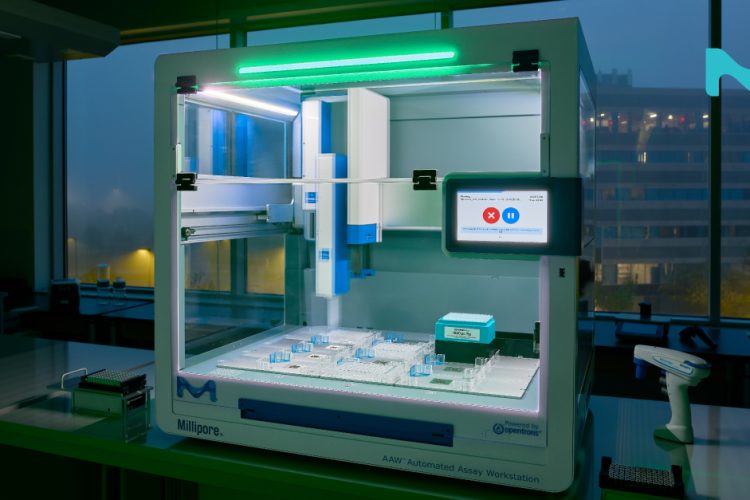Accessible automation may change your day-to-day sooner than you think
Posted: 1 October 2025 | | No comments yet
Automation is fast and precise, but too often expensive and hard to use. Now modular, DIY tools are breaking down barriers and putting lab automation in every researcher’s hands.


“I do a lot of work in molecular biology”
“I work in a proteomics lab”
“I spend my day-to-day running cell assays”
“I prepare samples for mass spec”
“I heavily use immunoassay in my research”
Researchers that carry out these tasks have diverse goals and workflows, but they all require repetitive, careful sample preparation. As laboratories move into the future, these researchers are looking for solutions that make these steps easier, more efficient and precise.
It is clear that the lab work is changing – and this future is getting closer. But while automation brings efficiency, it also traditionally brings a high bar for training, cost and standardisation.
While it can be hard to keep up with the fast-paced changes in the world of digitalisation and automation techniques, it is necessary in order to stay relevant and reach solutions faster. Yet automation in the lab can be an overwhelming topic.
The challenge with current automation options
Traditional sample prep and assay automation with common liquid handing systems requires extensive time and training, along with a new set of skills, to effectively operate and integrate into current lab processes. Some platforms require deep expertise in coding, licenses for the programming software, and even the hurdle of learning a custom programming language in order to make changes to a workflow. They also invite concerns of jobs becoming redundant due to being replaced by automated systems.
How lab automation is evolving
However, Merck is embracing the future of automation in the lab by making it more accessible. With the launch of its AAW™ automated assay workstation powered by Opentrons®, it is bringing affordable, modular, DIY automation to researchers. This is changing the game in the automation world as it puts the power of automation in the hands of researchers to adapt as they wish, rather than fitting the mould of existing automation solutions.
It allows the AAW workstation to essentially become a new partner in the lab, to help enhance the efficiency of work so that researchers can focus their time on other critical tasks, like analysing data, developing conclusions and questions, writing and innovating.
Why flexibility matters
The flexibility of Merck’s new automated assay workstation makes it possible for beginners to ease into automation, and allows for experienced automation experts to build advanced, integrated systems with its open-source API software.
The modularity of the new system also means researchers don’t need to know the full potential of their work up front – neither must they lock down a workflow at the time of purchase.
This enables researchers to adjust and adapt automated protocols to align with current processes, reagents and consumables, with no need to re-design protocols to match the restricted automation settings of traditional options.
The modularity of the new system also means researchers don’t need to know the full potential of their work up front – neither must they lock down a workflow at the time of purchase. The ability to add accessories and capabilities ad hoc themselves after onboarding the system, provides the power to turnkey to a variety of workflows as needed.
A chance for upskilling
The AAW workstation contains plug-and-play protocols and the option to develop unique protocols. No-code Protocol Designer app, open-source Python API, or design services to build specific protocols are available. For researchers interested in upskilling and learning some coding, this platform gives them a perfect opportunity to try out some new skills in a user-friendly way.
The power of consistency
Further enhancing the effortlessness of its workstation, Merck has also developed a Millipore® Protocol Library. The purchase of the AAW workstation gives researchers full access to its automated protocol library, which consists of verified automated assay and sample-prep protocols that have been developed by its R&D groups to provide accurate and reproducible automated processes for a variety of workflows.
With this library researchers can use existing kits and reagents as they were intended in an automated way – no need to develop and troubleshoot their own.
This library will continue to grow as new workflows are developed and verified. However, the goal is by automating Merck’s extensive assay portfolio across protein, molecular and cell biology applications, it will bring even more consistency in assay results. Data consistency helps reduce the amount of time spent re-running assays due to errors and provides researchers with data they can depend on, as well as some standardisation in their lab or across multiple labs. With this library researchers can use existing kits and reagents as they were intended in an automated way – no need to develop and troubleshoot their own.
Higher lab throughput
Of course, a major benefit of automating certain lab processes is the higher throughput. Automating with the AAW workstation allows researchers to focus on their other work while the workstation takes care of sample prep and running assays. This decreases hands-on time and increases throughput to help make research more efficient – a critical consideration for researchers who are focused on the science.
The future of lab work
Dynamic lab automation with the AAW automated assay workstation is helping to address the need for more efficient lab work while maintaining the integrity of current procedures and reagents. And being such an effortless automation option, this can really influence how labs may work in the future.
Related organisations
Merck



